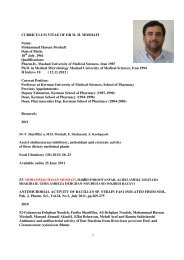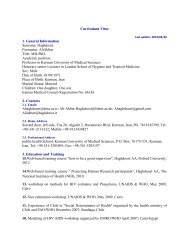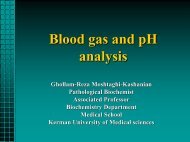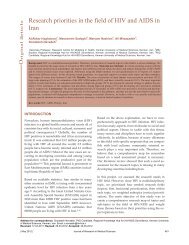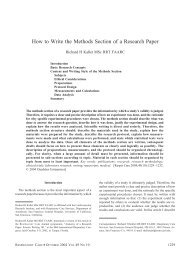Maternal malaria during pregnancy and infant mortality rate: critical ...
Maternal malaria during pregnancy and infant mortality rate: critical ...
Maternal malaria during pregnancy and infant mortality rate: critical ...
You also want an ePaper? Increase the reach of your titles
YUMPU automatically turns print PDFs into web optimized ePapers that Google loves.
J Vect Borne Dis 44, June 2007, pp. 97–103<strong>Maternal</strong> <strong>malaria</strong> <strong>during</strong> <strong>pregnancy</strong> <strong>and</strong> <strong>infant</strong> <strong>mortality</strong> <strong>rate</strong>: <strong>critical</strong>review of published papers <strong>and</strong> a new analytical approachAli A. Haghdoost a,b , Alex<strong>and</strong>er Neal b & Tom Smith ca Kerman University of Medical Science, Physiology Research Centre, Jomhoori Islami Blvd, Kerman, Iran; b London Schoolof Hygiene <strong>and</strong> Tropical Medicine, Keppel Street, London UK; c Swiss Tropical Institute Department of Public Health &Epidemiology, Socinstrasse, Switzerl<strong>and</strong>AbstractBackground & objectives: Malaria <strong>during</strong> <strong>pregnancy</strong> is a recognised risk factor for low birth weight<strong>and</strong> probably decreases the survival of offspring particularly <strong>during</strong> their first month of life. On theother h<strong>and</strong>, acquired maternal immunity may protect <strong>infant</strong>s against <strong>malaria</strong> infection or disease.This study assesses these two opposite effects simultaneously.Methods: We used the data of a large epidemiological study on <strong>malaria</strong> (Garki project) to analyse theimpact of <strong>malaria</strong> <strong>during</strong> <strong>pregnancy</strong> on survival of offspring in their first year of life. The datasetcontains 1,38,197 survey records, representing around 13,000 subjects. Of 663 reported deliveries,417 could be linked to survival data for the newborn.Results: The <strong>mortality</strong> <strong>rate</strong> <strong>during</strong> the first year of life was independent of maternal <strong>malaria</strong> infection<strong>during</strong> <strong>pregnancy</strong> (crude <strong>rate</strong> ratio 1.0). After adjustment for <strong>malaria</strong> in infancy, the <strong>rate</strong> ratio was1.2. The corresponding <strong>rate</strong> ratios for maternal <strong>malaria</strong> <strong>during</strong> the second half of <strong>pregnancy</strong> were1.46 <strong>and</strong> 1.73. None of these <strong>rate</strong> ratios was statistically significant. This may be due to smallnumber of deaths in the first year of life with a complete record of maternal <strong>malaria</strong> (27 deaths).Infants <strong>during</strong> the first four months of life had the lowest risk for Plasmodium falciparum, P. <strong>malaria</strong>e<strong>and</strong> P. ovale infection which may be partly due to acquired maternal immunity. There was a positiveassociation between <strong>malaria</strong> <strong>during</strong> <strong>pregnancy</strong> <strong>and</strong> <strong>malaria</strong> <strong>during</strong> first year of life which might bedue to similarity in exposure risks within a family, or confounding effects of socioeconomic status.However, this association was weaker in the first four months of life, <strong>and</strong> in those women whocontracted infection <strong>during</strong> the second half of <strong>pregnancy</strong>. This may indicate that acquired immunityis stronger in this group <strong>and</strong> partially protects babies for a few months.Interpretation & conclusion: It seems that on the whole, <strong>malaria</strong> <strong>during</strong> <strong>pregnancy</strong> was not a majorrisk factor for <strong>infant</strong> <strong>mortality</strong> in the Garki project. These results suggest that ignoring acquiredmaternal immunity may overestimate the hazard of <strong>malaria</strong> <strong>during</strong> <strong>pregnancy</strong> on <strong>infant</strong> survival.Key wordsGarki project – input <strong>mortality</strong> – maternal <strong>malaria</strong>IntroductionMalaria <strong>during</strong> <strong>pregnancy</strong>, particularly close to term,may entail two opposite effects on child survival. It mayprotect the <strong>infant</strong> against <strong>malaria</strong> infection <strong>and</strong> severedisease via acquired maternal immunity (AMI) 1–5 . Or itmay increase the risk of <strong>infant</strong> <strong>mortality</strong>, particularlyneonatal <strong>mortality</strong>, mostly by increasing the risk of lowbirth weight, premature labour, intra-uterine growthretardation, placental infection <strong>and</strong> stillbirth 6–14 .
HAGHDOOST et al : MATERNAL MALARIA AND IMR 99In the second approach, the impact of <strong>malaria</strong> infection<strong>during</strong> <strong>pregnancy</strong> on IMR <strong>and</strong> AMI were assessed.Sepa<strong>rate</strong> analyses were done for each half of<strong>pregnancy</strong> <strong>and</strong> for <strong>pregnancy</strong> as a whole, using Coxregression. For each analysis, women were includedif they had at least one slide result, <strong>and</strong> they wereclassified as positive if at least one of the slides waspositive. These models were run in Stata version 8.0.<strong>Maternal</strong> infection status is imperfectly observed inthis study, being based on slides made at intervals ofapproximately 2–4 months, <strong>and</strong> with some mothershaving more slides than others. To quantify the uncertainityresulting from this variable sampling, wefitted a Bayesian model by Markov Chain MonteCarlo using WinBUGS version 1.3. The IMR wasdefined as the number of deaths per year of follow-upin the first year of life. This differs from the commondefinition, i.e. the number of deaths in first year of lifeas a proportion of the number of births.ResultsThe mean age, <strong>and</strong> the frequency of <strong>malaria</strong> infectionsamong pregnant women in the three surveysbefore delivery, did not differ significantly betweenwomen whose pregnancies could be matched with ababy <strong>and</strong> those whose could not (p = 0.41 <strong>and</strong> 0.58respectively).The mean <strong>and</strong> st<strong>and</strong>ard deviation of age of mothersat the beginning of their pregnancies were 28.6 <strong>and</strong>6.6 yr respectively (minimum <strong>and</strong> maximum of 12.2<strong>and</strong> 48.1 yr). Around 29.4% of pregnant women hadat least one positive slide for <strong>malaria</strong> [30% (112slides) <strong>and</strong> 28.6% (109 slides) in the first <strong>and</strong> secondhalves of <strong>pregnancy</strong>] <strong>and</strong> around 47% P. falciparum.The frequency of P. falciparum infection in <strong>infant</strong>s(less than one year of age) was 53%, while the correspondingfrequencies for P. <strong>malaria</strong>e <strong>and</strong> P. ovalewere 9 <strong>and</strong> 2%, respectively. Around 23.5% of<strong>infant</strong> deaths were below the age of one month(8 deaths), while only one percent of positive bloodslides of babies belonged to this age group. Overall,the risk of <strong>malaria</strong> in those who died as <strong>infant</strong>s was30.2%, while in the first year of life for those whoreached age one year, it was 8.8% (p = 0.009 by Fisher’sexact test).The risk ratios for maternal <strong>malaria</strong> infection in thefirst <strong>and</strong> second halves of <strong>pregnancy</strong> for IMR were0.74 <strong>and</strong> 1.46, respectively, but neither was statisticallysignificant (Table 1). For maternal infection atany time <strong>during</strong> <strong>pregnancy</strong>, taking into account thevarying number of slides by the Bayesian model,produced a <strong>rate</strong> ratio for IMR of 1.05 with a wider95% confidence interval (0.32–4.1).Adjusting for the <strong>infant</strong>’s <strong>malaria</strong> infection increasedthe <strong>rate</strong> ratios, more so for the second half of <strong>pregnancy</strong>(crude RR = 1.46, adjusted RR = 1.73) than thefirst. In other words, having adjusted for a potentialprotective effect of maternal acquired immunity,Table 1. Infant <strong>mortality</strong> <strong>rate</strong>s according to maternal <strong>malaria</strong> infection <strong>during</strong> <strong>pregnancy</strong>Time of infection No. of deaths No. of deaths Rate ratio Adjusted <strong>rate</strong><strong>during</strong> <strong>pregnancy</strong> in slide-negative in slide-positive (95% CI) ratio (95% CI)group (person-years) group (person-years)First half 22 (169.1) 7 (79.9) 0.74 (0.31–1.72) 0.83 (0.36–1.96)Second half 19 (188.1) 11 (74.2) 1.46 (0.7–3.07) 1.73 (0.8–3.58)Any time 14 (125.12) 13 (123.89) 1.00 (0.47–2.14) 1.20 (0.56–2.56)Due to their definitions, the numbers in last row is not the sum of the numbers in two first rows (see the lastparagraph of subjects <strong>and</strong> methods section)
100 J VECT BORNE DIS 44, JUNE 2007Table 2. The risk of infection with Plasmodium spp classified by ageAge group 10 year TotalNo. (%) No. (%) No. (%) No. (%) No. (%)P. falciparumNegative 484 (70.7) 356 (42) 272 (31.6) 2,220 (13.5) 27,902 (64.6) 31,234Positive 201 (29.3) 492 (58) 558 (68.4) 14,224 (86.5) 15,299 (35.4) 30,804OR 0.75 2.52 3.9 11.68 1 χ 2 =1270*(95% CI) (0.64–0.9) (2.2–2.9) (3.41–4.56) (11.13–12.27) – p
HAGHDOOST et al : MATERNAL MALARIA AND IMR 101Table 3. The ORs between maternal <strong>malaria</strong> infection <strong>during</strong> <strong>pregnancy</strong> <strong>and</strong>infections in their off springMalaria <strong>during</strong><strong>pregnancy</strong>Malaria in <strong>infant</strong>s8 monthsP. falciparumFirst half 2.8 (0.84–9.3) 2 (0.79–5.03) 1.78(0.8–3.98)Second half 1.55(0.52–4.6) 3.1 (1.05–9.13) 2.1 (0.98–4.42)Any time 1.58(0.6–4.1) 2.6 (1.12–6.1) 1.94(0.96–3.9)P. <strong>malaria</strong>eFirst half – 0.31(0.03–3.2) 1.28(0.26–6.25)Second half 0.84(0.16–4.55) 1.05(0.26–4.2) 1.93(0.57–6.6)Any time 0.63(0.12–3.3) 0.73(0.23–2.37) 1.97(0.71–5.4)Any speciesFirst half 2.8 (0.86–9.2) 2.2 (0.87–5.52) 1.87(0.85–4.1)Second half 1.43(0.5–4.1) 1.96(0.77–4.98) 2.2 (1.06–4.58)Any time 1.63(0.59–4.52) 3.1 (1.23–7.81) 2.48(1.14–5.37)exposure risk of mothers <strong>and</strong> <strong>infant</strong>s; i.e. in highlyexposed families, both mothers <strong>and</strong> <strong>infant</strong>s had higherinfection risks. However, this positive associationwas weaker in <strong>infant</strong>s with less than four months age;<strong>and</strong> for those mothers who contracted infection in thesecond half of their pregnancies (Table 3). These findingswere comparable for P. falciparum <strong>and</strong> P. <strong>malaria</strong>einfections <strong>and</strong> may imply that AMI gene<strong>rate</strong>dstronger protection in the first four months of <strong>infant</strong>life, particularly in those pregnant women who contractedinfection in second half of <strong>pregnancy</strong>.DiscussionWe did not find evidence for a detrimental effect of<strong>malaria</strong> in <strong>pregnancy</strong> on <strong>infant</strong> survival. The data areconsistent with a mode<strong>rate</strong> to large risk, but the 95%confidence interval for the <strong>rate</strong> ratio is wide even fromthe model without allowing for variable number ofslides (0.44–2.0). The point estimate allowing for thiswas similar, but had an even wider confidence interval.On the whole, <strong>malaria</strong> infection <strong>during</strong> <strong>pregnancy</strong>could account for around 6% of the IMR. Our analysissuggests that the effect of <strong>malaria</strong> infection onoffspring survival in the second half of <strong>pregnancy</strong> isstronger than in the first half, which might be due toits effect on birth-weight. In addition, infection <strong>during</strong><strong>pregnancy</strong> may produce partial immunity in <strong>infant</strong>s,particularly in their first four months life.The short protective effect of AMI which observedin this study is compatible with other published results2–5,21 . Sehgal et al 3 showed that maternal immunoglobulinG (IgG) was detectable in newborn babiesfor around 4–7 months <strong>and</strong> its level had a negative associationwith the risk of <strong>malaria</strong> infection. Kitua etal 5 found that age profiles of <strong>malaria</strong> disease <strong>and</strong> ofthe density of parasitaemia also complement those ofmaternal IgG. It seems that <strong>infant</strong>s obtain partialprotection against <strong>malaria</strong> if the mother contractedinfection in late part of her <strong>pregnancy</strong>; but this protectionis effective for only a few months.There is a great deal of research on the hazards of<strong>malaria</strong> <strong>during</strong> <strong>pregnancy</strong> on mothers <strong>and</strong> babieshealth 22 . Most clinical trials have found that prophylaxiswith anti<strong>malaria</strong> <strong>during</strong> <strong>pregnancy</strong> increasedbirth weight <strong>and</strong> decreased the frequency of neonatal<strong>mortality</strong> 9,11,13,16-19 . Greenwood et al 12 concludedthat maternal <strong>malaria</strong> prophylaxis could reduce IMR
102 J VECT BORNE DIS 44, JUNE 2007by around 18% among the children of primigravidae,<strong>and</strong> by around 4% among the children of multigravidae.However, this prediction was based on theeffect of prophylaxis on the birth weight <strong>and</strong> was notadjusted for presumably protective effect of AMI.It is not clear whether low birth weight is on the causalpathway between maternal <strong>malaria</strong> <strong>and</strong> <strong>infant</strong> <strong>mortality</strong>,<strong>and</strong> accu<strong>rate</strong> prediction of the impact of <strong>malaria</strong>control measures targeted at pregnant women requiresdirect estimates of <strong>malaria</strong> attributable neonatal<strong>mortality</strong> <strong>rate</strong>s 22 . We estimate that <strong>malaria</strong> <strong>during</strong>the whole <strong>pregnancy</strong> did not have any contribution onIMR (PAF = – 0.01) which is compatible with theresults of studies which followed babies for oneyear 6,11 . However, the adjusted PAF for maternalimmunity was 0.06, which may imply that withoutallowing for AMI effect, <strong>malaria</strong> <strong>during</strong> <strong>pregnancy</strong>slightly increased the IMR. The adjusted OR is closeto the prediction of Steketee et al 7 (3–8%). Therefore,the observed difference between studies might be dueto the impact of AMI.It should be mentioned that our definition of IMR isthe number of deaths divided by the person monthsof follow-up, which is different to its conventionaldefinition. However, we do not expect this differencehad any impact on the final conclusion.The crude <strong>and</strong> adjusted PAF of <strong>malaria</strong> <strong>during</strong> thesecond half of <strong>pregnancy</strong> on IMR were 0.12 <strong>and</strong> 0.16respectively, showing that <strong>malaria</strong> <strong>during</strong> the secondhalf of <strong>pregnancy</strong> is a stronger risk factor for IM.Nonetheless, perhaps due to the low number of deathsin first year of life, none of these PAFs was statisticallysignificant.It seems that even the large database from Garki is inadequatefor accu<strong>rate</strong>ly measuring the specific associationbetween <strong>malaria</strong> <strong>during</strong> <strong>pregnancy</strong> <strong>and</strong> IM. Thisassociation was not a primary objective in the Garkiproject; <strong>and</strong> the number of births that could be linkedto maternal <strong>malaria</strong> status was nevertheless small, sothe confidence limits for the estimates are wide.ConclusionAround six percent of IMR could be attributed tomaternal <strong>malaria</strong> <strong>during</strong> <strong>pregnancy</strong>. It seems that mostof studies over-estimated the impact of <strong>malaria</strong> onsurvival of <strong>infant</strong>s because they do not consider protectiveeffect of AMI. To demonst<strong>rate</strong> unequivocallyan excess risk of <strong>infant</strong> <strong>mortality</strong> would require a largelongitudinal study, which would also need to measurepossible confounding factors such as socioeconomicstatus <strong>and</strong> taking into account for AMI.AcknowledgementWe thank Paulette Rozé <strong>and</strong> Louis Molineaux fortheir work in helping to make the Garki dataset availablefor this analysis.References1. Desowitz RS, Elm J, Alpers MP. Plasmodium falciparumspecificimmunoglobulin G (IgG), IgM, <strong>and</strong> IgE antibodiesin paired maternal-cord sera from east SepikProvince, Papua New Guinea. Infect Immun 1993; 61(3):988–93.2. Okoko BJ, Enwere G, Ota MO. The epidemiology <strong>and</strong>consequences of maternal <strong>malaria</strong>: a review of immunologicalbasis. Acta Trop 2003; 87(2): 193–205.3. Sehgal VM, (Au: Pls. Check Spell)? Siddiqui WA, AlpersMP. A seroepidemio-logical study to evaluate the role ofpassive maternal immunity to <strong>malaria</strong> in <strong>infant</strong>s. Trans RSoc Trop Med Hyg 1989; 83(Suppl): 105–6.4. Rasheed FN, Bulmer JN, De Francisco A, Jawla MF,Jakobsen PH, Jepson A, et al. Relationships betweenmaternal <strong>malaria</strong> <strong>and</strong> <strong>malaria</strong>l immune responses inmothers <strong>and</strong> neonates. Parasit Immunol 1995; 17(1):1–10.5. Kitua AY, Smith T, Alonso PL, Masanja H, Urassa H,Menendez C, et al. Plasmodium falciparum <strong>malaria</strong> inthe first year of life in an area of intense <strong>and</strong> perennialtransmission. Trop Med Int Hlth 1996; 1(4): 475–84.6. Luxemburger C, McGready R, Kham A, Morison L, ChoT, Chongsuphajaisiddhi T, White NJ, Nosten F. Effects of<strong>malaria</strong> <strong>during</strong> <strong>pregnancy</strong> on <strong>infant</strong> <strong>mortality</strong> in an area
HAGHDOOST et al : MATERNAL MALARIA AND IMR 103of low <strong>malaria</strong> transmission. Am J Epidemiol 2001; 154(5):459–65.7. Steketee RW, Nahlen BL, Parise ME, Menendez C. Theburden of <strong>malaria</strong> in <strong>pregnancy</strong> in <strong>malaria</strong>-endemic areas.Am J Trop Med Hyg 2001; 64(Suppl 1–2): 28–35.8. Newman RD, Hailemariam A, Jimma D, Degifie A,Kebede D, Rietveld AE, et al. Burden of <strong>malaria</strong> <strong>during</strong><strong>pregnancy</strong> in areas of stable <strong>and</strong> unstable transmission inEthiopia <strong>during</strong> a nonepidemic year. J Infect Dis 2003;187(11): 1765–72.9. Parise ME, Ayisi JG, Nahlen BL, Schultz LJ, Roberts JM,Misore A, et al. Efficacy of sulfadoxine-pyrimethaminefor prevention of placental <strong>malaria</strong> in an area of Kenyawith a high prevalence of <strong>malaria</strong> <strong>and</strong> human immunodeficiencyvirus infection. Am J Trop Med Hyg 1998;59(5): 813–22.10. Cot M, Brutus L, Pinell V, Ramaroson H, Raveloson A,Rabeson D, Rakotonjanabelo AL. Malaria prevention<strong>during</strong> <strong>pregnancy</strong> in unstable transmission areas: thehighl<strong>and</strong>s of Madagascar. Trop Med Int Hlth 2002; 7(7):565–72.11. Nosten F, Ter Kuile F, Maelankiri L, ChongsuphajaisiddhiT, Nopdonrattakoon L, Tangkitchot S, et al. Mefloquineprophylaxis prevents <strong>malaria</strong> <strong>during</strong> <strong>pregnancy</strong>: a doubleblind,placebo-controlled study. J Infect Dis 1994; 169(3):595–603.12. Greenwood AM, Armstrong JR, Byass P, Snow RW,Greenwood BM. Malaria chemoprophylaxis, birth weight<strong>and</strong> child survival. Trans R Soc Trop Med Hyg 1992; 86(5):483–5.13. Greenwood AM, Menendez C, Todd J, Greenwood BM.The distribution of birth weights in Gambian women whoreceived <strong>malaria</strong> chemoprophylaxis <strong>during</strong> their first<strong>pregnancy</strong> <strong>and</strong> in control women. Trans R Soc Trop MedHyg 1994; 88(3): 311–2.14. Greenwood BM, Greenwood AM, Snow RW, Byass P,Bennett S, Hatib-N’Jie AB. The effects of <strong>malaria</strong>chemoprophylaxis given by traditional birth attendants onthe course <strong>and</strong> outcome of <strong>pregnancy</strong>. Trans R Soc TropMed Hyg 1989; 83(5): 589–94.15. Phillips-Howard PA, Nahlen BL, Kolczak MS, HightowerAW, Ter Kuile FO, Alaii JA, et al. Efficacy of permethrintreatedbednets in the prevention of <strong>mortality</strong> in youngchildren in an area of high perennial <strong>malaria</strong> transmissionin western Kenya. Am J Trop Med Hyg 2003; 68(Suppl4): 23–9.16. Menendez C, Todd J, Alonso PL, Lulat S, Francis N,Greenwood BM. Malaria chemoprophylaxis, infection ofthe placenta <strong>and</strong> birth weight in Gambian primigravidae.J Trop Med Hyg 1994; 97(4): 244–8.17. Steketee RW, Wirima JJ, Hightower AW, Slutsker L,Heymann DL, Breman JG. The effect of <strong>malaria</strong> <strong>and</strong><strong>malaria</strong> prevention in <strong>pregnancy</strong> on offspring birthweight, prematurity, <strong>and</strong> intrauterine growth retardationin rural Malawi. Am J Trop Med Hyg 1996; 55(Supp1):33–41.18. Cot M, Le Hesran JY, Miailhes P, Esveld M, Etya’ale D,Breart G. Increase of birth weight following chloroquinechemoprophylaxis <strong>during</strong> the first <strong>pregnancy</strong>: results of ar<strong>and</strong>omized trial in Cameroon. Am J Trop Med Hyg 1995;53(6): 581–5.19. Bouvier P, Breslow N, Doumbo O, Robert CF, PicquetM, Mauris A, Dolo A, Dembele HK, Delley V, RougemontA. Seasonality, <strong>malaria</strong>, <strong>and</strong> impact of prophylaxis in aWest African village. II: Effect on birth weight. Am J TropMed Hyg 1997; 56(4): 384–9.20. Molyneux L. The Garki project: Research on theepidemiology <strong>and</strong> control of <strong>malaria</strong> in the Sudan Savannaof West Africa: WHO. (Au: Place Ps.)21. Riley EM, Wagner GE, Ofori MF, Wheeler JG, AkanmoriBD, Tetteh K, et al. Lack of association between maternalantibody <strong>and</strong> protection of African <strong>infant</strong>s from <strong>malaria</strong>infection. Infect Immun 2000; 68(10): 5856–63.22. Ross A, Smith T. The effect of <strong>malaria</strong> transmissionintensity on neonatal <strong>mortality</strong> in endemic areas. Am JTrop Med Hyg 2006; 75(Suppl 2): 74–81.Corresponding author:Dr. Ali A. Haghdoost, Kerman University of Medical Science, Physiology Research Centre, JomhooriIslami Blvd, Postal code: 7618747653, Kerman, IranE-mail: Ahaghdoost@kmu.ac.ir; Ali-Akbar.haghdoost@lshtm.ac.ukReceived: 22 September 2006 Accepted in revised form: 19 January 2007



